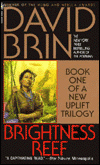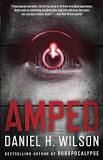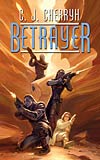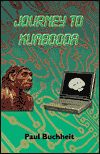
Brightness Reef, by David Brin
Book Review by Richard R. Horton
Have you read this book?
Brightness Reef is the latest of David Brin`s "Uplift" series of novels, which began with his first novel, Sundiver, originally published in 1980. (Many of his books, I should note, are not in the "Uplift" series.) This series has been very successful, and in fact both of Sundiver`s successors, Startide Rising and The Uplift War won major SF awards.
Briefly, the main premise of the "Uplift" universe is that all sapient races were "uplifted" to intelligence by genetic modifications performed by an older "Patron" race, in a genealogical sequence stretching back millions of years to the fabled Progenitors. Galactic society is a complex web of alliances, mainly based on the ties of Patron races to their "Clients" (who are bound to patrons for a period of "indenture" after their uplift). The alliances seem to differ on such issues as permissible degrees of genetic alteration of clients (some Patrons unethically modify their clients for excessive servility, for instance), proper length of indenture periods, and degree of respect (or worship) for the (long-disappeared) Progenitors. One of the main economic forces in this Universe is the struggle for rights to new potential clients (pre-sapient races). I think this set-up is one of the most original and interesting SF ideas of recent times, in particular with regard to establishing a (somewhat) believable Multi-Race Galactic society.
Naturally, humans occupy a rather unique place in this universe. At the time Galactics discover Earth (sometime in the 21st century), humans are already demonstrably sapient, and moreover have "uplifted" dolphins and chimps to sapience. The earlier books treat aspects of the ensuing Galactic controversy: were Humans uplifted, and, if so, where have their Patrons gone? Should Humans and their Clients be transferred to another Patron race for further modification and a period of indenture? Could Humans actually have somehow "bootstrapped" themselves to sapience (a view regarded as blasphemy in some Galactic circles)? Each novel is self-standing, although they also raise larger questions which are never answered (Startide Rising is particularly frustrating in this regard).
Brightness Reef is a new departure for the "Uplift" series. The focus shifts from Earth and Earth`s immediate allies to a remote world called Jijo. This world has been illegally colonized by no less than 7 different sapient races, of which at the time of the action 6 are allied in the "Commons" while one race has already devolved to a pre-sapient condition.
One of the prime foci of the novel is the "illegal" nature of the multiple colonization of Jijo. Jijo is a "fallow" world, one which was previously leased and developed (to quite an extensive level) by a Galactic race, the Buyur. Galactic law requires that such worlds, after their lease expires, be left fallow for an extensive period of time, to allow the world to heal itself environmentally, and hopefully to allow the development of new pre-sapient races (Uplift candidates.) Thus the six races of the Commons are disturbing the recovery period of this world, and they risk severe punishment (for their entire species) if discovered. To avoid discovery, they have purposely occupied a geologically active part of the world (the better to promote long-term concealment of their works) and they use only very "Green" technologies: with the dual purpose of being more difficult to detect from space, and disturbing the planet less. Much of the interest in the book comes from some of the political conflicts which result: some wish to abandon technology altogether and promote a return to "innocence": devolution back to pre-sapience, in fact; others wish to maintain as much technology as possible, but still quite sincerely wish to avoid ruining Jijo, a more radical group wishes to (either voluntarily or violently) end all illegal habitation on the planet. All live in constant fear of Galactic discovery.
The main events of the novel begin with this event finally happening: a Galactic starship lands. However, it is not exactly what is seems: in fact, it too is a criminal ship, though its exact purposes remain a matter for speculation. The novel follows the actions of 6 or 7 separate point-of-view characters in response to the starship`s landing. There is a good deal of action, and a few questions are answered, but many more questions are raised. By the end of the book, the stage has been set for some very interesting future novels, but this book turns out to be nothing but exposition.
Ah, but what exposition! That is the strength of this novel: Brin sets up a complex society of (at least) 6 mutually alien races. The races themselves are interesting physically: the Centauroid Urs, the Hoon, the composite-personalitied Traeki, the wheeled G`Kek, and the vaguely crustacean Qheuens, as well as humans. He works hard to make the aliens convincing both physically and psychologically: quite successfully in the first case, but less so (of course) in the second case, although at least the Traeki are fairly well depicted in that regard. In addition to the interesting depictions of the aliens, the Jijoan culture is quite interesting, as a radically Green culture on the one hand, and also as a model for inter-species interaction and cooperation.
Finally, the main characters are interesting as well: there are five main human characters: three siblings who represent three divergent political viewpoints (and who each have differing knowledge of Jijo: thus promoting painless description of the setting), a young girl from an illegal "Sooner" band which has colonized a forbidden part of the planet, and a mysterious "Stranger" who tantalizingly seems linked with the events of Startide Rising. There are also two alien viewpoint characters: the Traeki sage Asx, who acts as sort of a Chorus, advancing the main line of the story, and the young Hoon Alvin (nicknamed for the protagonist of Clarke`s The City and the Stars, thus conveniently a "humicker" (Human mimicker), allowing Brin to get away with the Human feel of Alvin`s narrative.) By the end of the story, each main character is left in suspense, and in considerable danger. A great deal of intriguing events happen rapidly toward the finish, and it seems that the real story will begin in the next book
Clearly, this is a frustratingly incomplete story. Brin recognizes this, and apologizes in an afterword, confessing that his story got out of his control, so to speak. He promises that the next books in the trilogy will be finished as quickly as possible. I enjoyed the book a lot, but certainly I anticipate the subsequent volumes eagerly, and many might wish to wait until the whole trilogy is at hand.
Briefly, the main premise of the "Uplift" universe is that all sapient races were "uplifted" to intelligence by genetic modifications performed by an older "Patron" race, in a genealogical sequence stretching back millions of years to the fabled Progenitors. Galactic society is a complex web of alliances, mainly based on the ties of Patron races to their "Clients" (who are bound to patrons for a period of "indenture" after their uplift). The alliances seem to differ on such issues as permissible degrees of genetic alteration of clients (some Patrons unethically modify their clients for excessive servility, for instance), proper length of indenture periods, and degree of respect (or worship) for the (long-disappeared) Progenitors. One of the main economic forces in this Universe is the struggle for rights to new potential clients (pre-sapient races). I think this set-up is one of the most original and interesting SF ideas of recent times, in particular with regard to establishing a (somewhat) believable Multi-Race Galactic society.
Naturally, humans occupy a rather unique place in this universe. At the time Galactics discover Earth (sometime in the 21st century), humans are already demonstrably sapient, and moreover have "uplifted" dolphins and chimps to sapience. The earlier books treat aspects of the ensuing Galactic controversy: were Humans uplifted, and, if so, where have their Patrons gone? Should Humans and their Clients be transferred to another Patron race for further modification and a period of indenture? Could Humans actually have somehow "bootstrapped" themselves to sapience (a view regarded as blasphemy in some Galactic circles)? Each novel is self-standing, although they also raise larger questions which are never answered (Startide Rising is particularly frustrating in this regard).
Brightness Reef is a new departure for the "Uplift" series. The focus shifts from Earth and Earth`s immediate allies to a remote world called Jijo. This world has been illegally colonized by no less than 7 different sapient races, of which at the time of the action 6 are allied in the "Commons" while one race has already devolved to a pre-sapient condition.
One of the prime foci of the novel is the "illegal" nature of the multiple colonization of Jijo. Jijo is a "fallow" world, one which was previously leased and developed (to quite an extensive level) by a Galactic race, the Buyur. Galactic law requires that such worlds, after their lease expires, be left fallow for an extensive period of time, to allow the world to heal itself environmentally, and hopefully to allow the development of new pre-sapient races (Uplift candidates.) Thus the six races of the Commons are disturbing the recovery period of this world, and they risk severe punishment (for their entire species) if discovered. To avoid discovery, they have purposely occupied a geologically active part of the world (the better to promote long-term concealment of their works) and they use only very "Green" technologies: with the dual purpose of being more difficult to detect from space, and disturbing the planet less. Much of the interest in the book comes from some of the political conflicts which result: some wish to abandon technology altogether and promote a return to "innocence": devolution back to pre-sapience, in fact; others wish to maintain as much technology as possible, but still quite sincerely wish to avoid ruining Jijo, a more radical group wishes to (either voluntarily or violently) end all illegal habitation on the planet. All live in constant fear of Galactic discovery.
The main events of the novel begin with this event finally happening: a Galactic starship lands. However, it is not exactly what is seems: in fact, it too is a criminal ship, though its exact purposes remain a matter for speculation. The novel follows the actions of 6 or 7 separate point-of-view characters in response to the starship`s landing. There is a good deal of action, and a few questions are answered, but many more questions are raised. By the end of the book, the stage has been set for some very interesting future novels, but this book turns out to be nothing but exposition.
Ah, but what exposition! That is the strength of this novel: Brin sets up a complex society of (at least) 6 mutually alien races. The races themselves are interesting physically: the Centauroid Urs, the Hoon, the composite-personalitied Traeki, the wheeled G`Kek, and the vaguely crustacean Qheuens, as well as humans. He works hard to make the aliens convincing both physically and psychologically: quite successfully in the first case, but less so (of course) in the second case, although at least the Traeki are fairly well depicted in that regard. In addition to the interesting depictions of the aliens, the Jijoan culture is quite interesting, as a radically Green culture on the one hand, and also as a model for inter-species interaction and cooperation.
Finally, the main characters are interesting as well: there are five main human characters: three siblings who represent three divergent political viewpoints (and who each have differing knowledge of Jijo: thus promoting painless description of the setting), a young girl from an illegal "Sooner" band which has colonized a forbidden part of the planet, and a mysterious "Stranger" who tantalizingly seems linked with the events of Startide Rising. There are also two alien viewpoint characters: the Traeki sage Asx, who acts as sort of a Chorus, advancing the main line of the story, and the young Hoon Alvin (nicknamed for the protagonist of Clarke`s The City and the Stars, thus conveniently a "humicker" (Human mimicker), allowing Brin to get away with the Human feel of Alvin`s narrative.) By the end of the story, each main character is left in suspense, and in considerable danger. A great deal of intriguing events happen rapidly toward the finish, and it seems that the real story will begin in the next book
Clearly, this is a frustratingly incomplete story. Brin recognizes this, and apologizes in an afterword, confessing that his story got out of his control, so to speak. He promises that the next books in the trilogy will be finished as quickly as possible. I enjoyed the book a lot, but certainly I anticipate the subsequent volumes eagerly, and many might wish to wait until the whole trilogy is at hand.
| Brightness Reef, by David Brin on Amazon |
Brightness Reef, by David Brin on Amazon

| More Books You Might Like |
Comment on Brightness Reef, by David Brin
| Comments on Brightness Reef, by David Brin |
| There are no comments on this book. |




